
Rocky Mountain coal mine in Alberta takes next step to expansion
In Alberta, a massive open-pit coal mine near Jasper National Park is hoping to expand...
Under an early November snowfall, a tense standoff slowly unfolded between Coastal GasLink security workers, RCMP and Wet’suwet’en Hereditary Chief Na’moks.
“If you pass this gate, sir, my understanding is that you will be arrested by the RCMP,” a pipeline security guard told the Chief and his supporters. He was standing in front of a yellow gate across the access road to where the company is drilling under Wedzin Kwa (Morice River) about two kilometres away.
In 2019, the B.C. Supreme Court issued an injunction against anyone “obstructing, blocking, physically impeding or delaying access” in the area.
Na’moks told the security workers why he was there — to monitor the pipeline construction as part of his responsibilities as Chief — and assured them he had no intention of impeding any work. He had previously visited the site numerous times without incident.
“I am Chief Na’moks of the T’sayu Clan,” he said. “We will not be going into your worksite, we will be staying away from the worksite and on the road.”
“I work for Coastal GasLink and my responsibility is ensuring the safety and security of this active worksite,” the security guard said in response, reading from a prepared script. He provided his private investigator licence number and said he’s employed by Forsythe Security. “This work is lawful, authorized and permitted and we are conducting construction activities for Coastal GasLink. Be advised that there’s a court injunction order with enforcement,” the security guard said.
“Only previously arranged escorted site visits will be permitted for the duration of the work at this site for your safety and to allow our work to continue unimpeded. I ask that you contact Coastal GasLink and request an appointment for access to the site.”

Beside the gate, a sign notes the existence of the court order and states that anyone having notice of it is restrained and prohibited from physical interference with Coastal GasLink business. It also states that individuals are prohibited from “approaching within 10 metres of any individual or vehicle” being used for pipeline work and from “threatening or intimidating Coastal GasLink or other persons in a contractual or economic relationship with Coastal GasLink.”
However, the court order does not mention “threatening or intimidating” nor proximity to employees or vehicles. TC Energy did not clarify why these terms are included in the signage.
Canadian courts have confirmed that journalists have a Constitutional right to document events in an injunction zone and that injunctions do not apply to any journalist who is collecting or gathering information without interfering. A recent court decision has also warned that police should avoid interfering with the work of journalists by detaining them under an assumption that they would be released later. But the security guard suggested otherwise, warning The Narwhal not to cross the line.
“Based on what I’ve read to you, anybody passing this that is not an employee and does not have a right to be here, including the media, will be arrested by the RCMP,” the security worker told The Narwhal.
When asked about the incident, Madonna Saunderson, with the RCMP’s media relations team, said “the RCMP play an impartial role in the activities taking place along the Morice [forest service road] and engage where there are complaints of infractions breaching or contrary to the terms of the civil injunction that is in place.”
“The decision to arrest anyone in contravention of the laws, or breaching a court imposed injunction is done on a case by case,” Saunderson said, noting the RCMP do not moderate what happens at the gate.
“Forsythe Security is responsible for engaging with individuals at their gate,” she wrote. “Any questions with regard to their processes and security interactions should be forwarded to the Forsythe Security team leads. The RCMP’s role is to address any criminal matters when they are called to attend.”
A representative from Forsythe Security reached by phone told The Narwhal they would look into the matter but declined to comment.
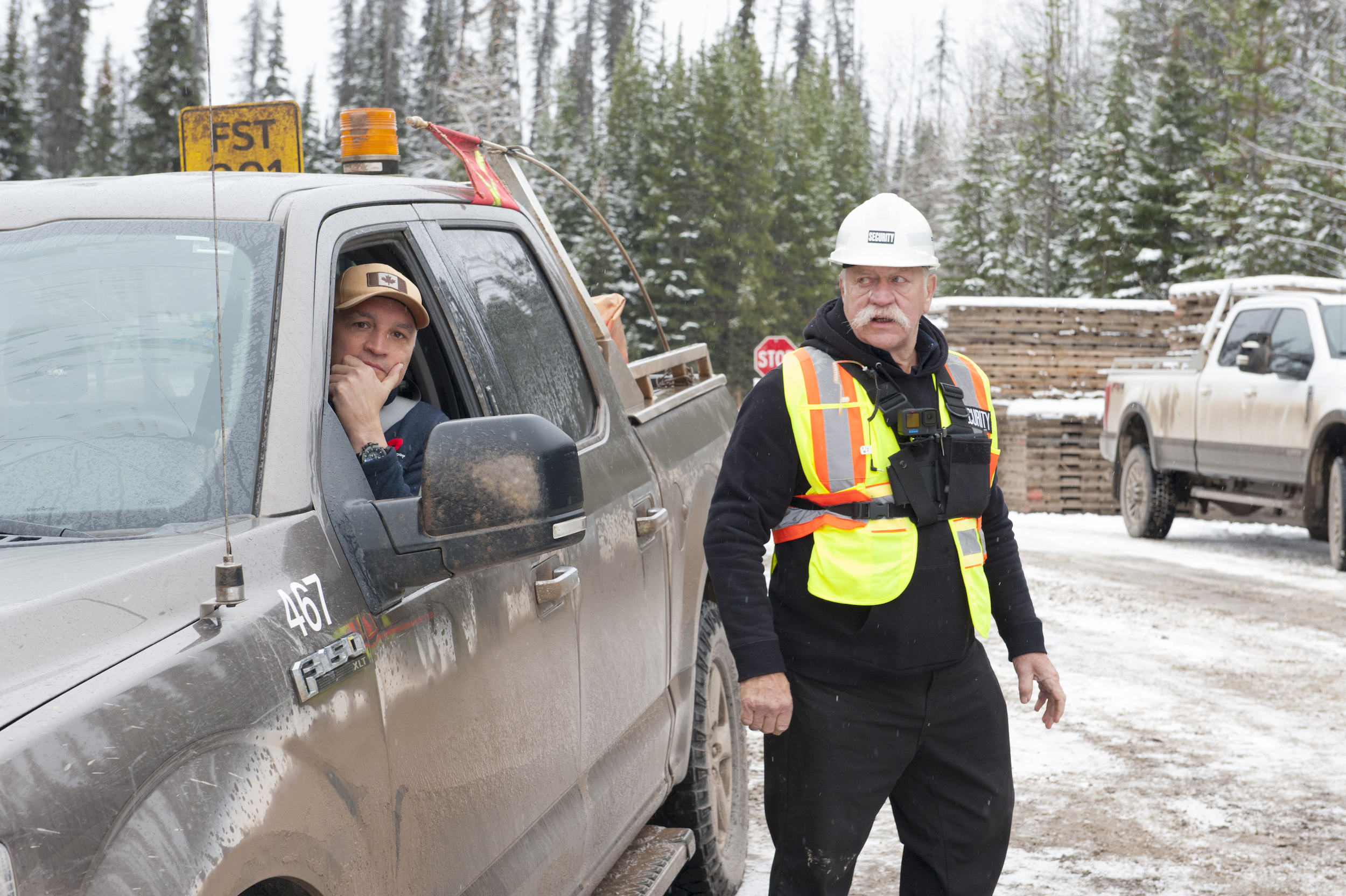
The role of the security firm in working for the pipeline company has not been without controversy. Wet’suwet’en community members have accused the RCMP, Coastal GasLink and Forsythe of a “relentless campaign of harassment and intimidation” in a civil lawsuit filed with the B.C. Supreme Court this summer. Forsythe denied any wrongdoing in its response and the allegations have not been proven in court.
When RCMP arrested journalists reporting on Wet’suwet’en resistance to the pipeline project last year, internal police emails promised a “package” that would justify their actions. That package has yet to materialize and Coastal GasLink subsequently dropped the charges.
TC Energy did not directly respond to questions about why Chief Na’moks was denied access nor whether it believes a journalist should be arrested for documenting within an injunction zone.
“The safety of our workforce, contractors, local Indigenous and non-Indigenous community members and the public is paramount to us,” the company wrote in an email. “Coastal GasLink has an obligation to control access to its worksites to ensure the safety of both the public and its workers which includes restricting access to existing roads, trails and travel ways at active work areas. Safe access for community members is facilitated through a defined process that has been communicated to the Office of the Wet’suwet’en, Hereditary Chiefs, elected Wet’suwet’en leadership and house members.”
Kris Statnyk, Na’moks’ legal counsel, was standing at the gate with him. He asked to speak with the RCMP, noting the private security workers do not have authority to enforce the court injunction.
After about twenty minutes, Sergeant Jason Charney, with the force’s Community-Industry Response Group, walked toward the gate, but stopped short and waved a security worker over. They spoke briefly and Charney walked away. The Community-Industry Response Group, commonly called C-IRG, is a special unit of the force set up in 2017 to police opposition to industrial projects.
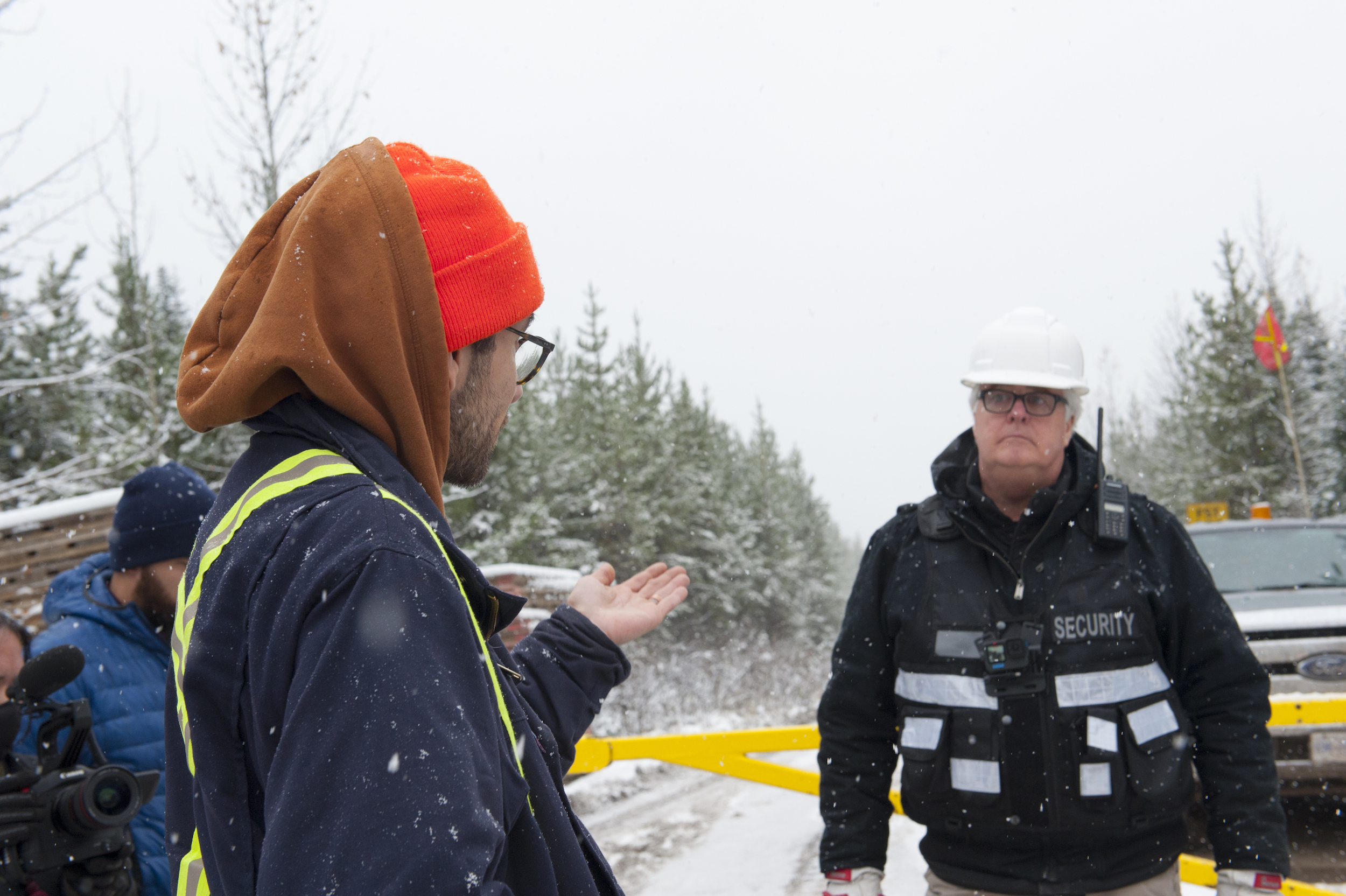
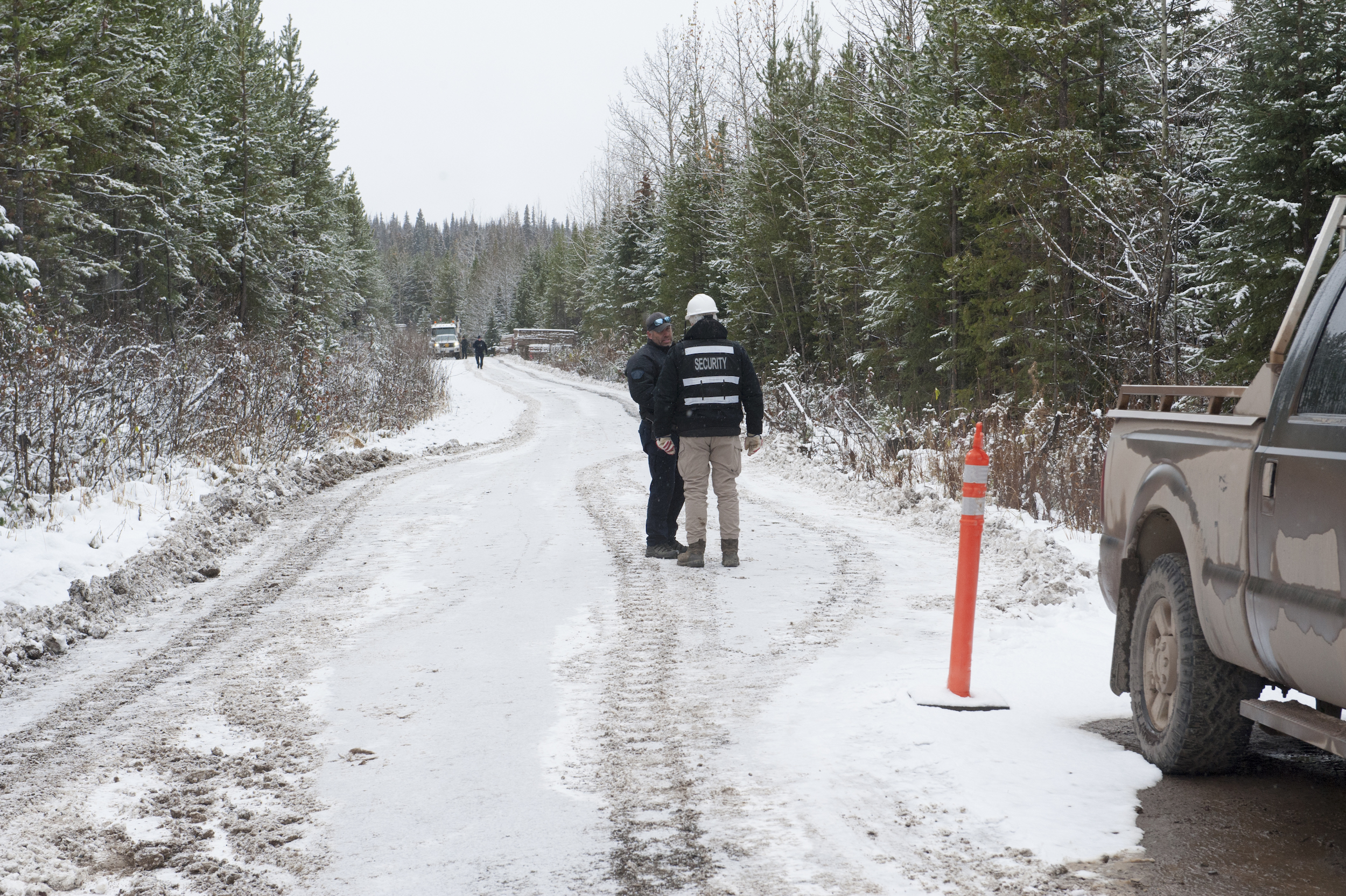
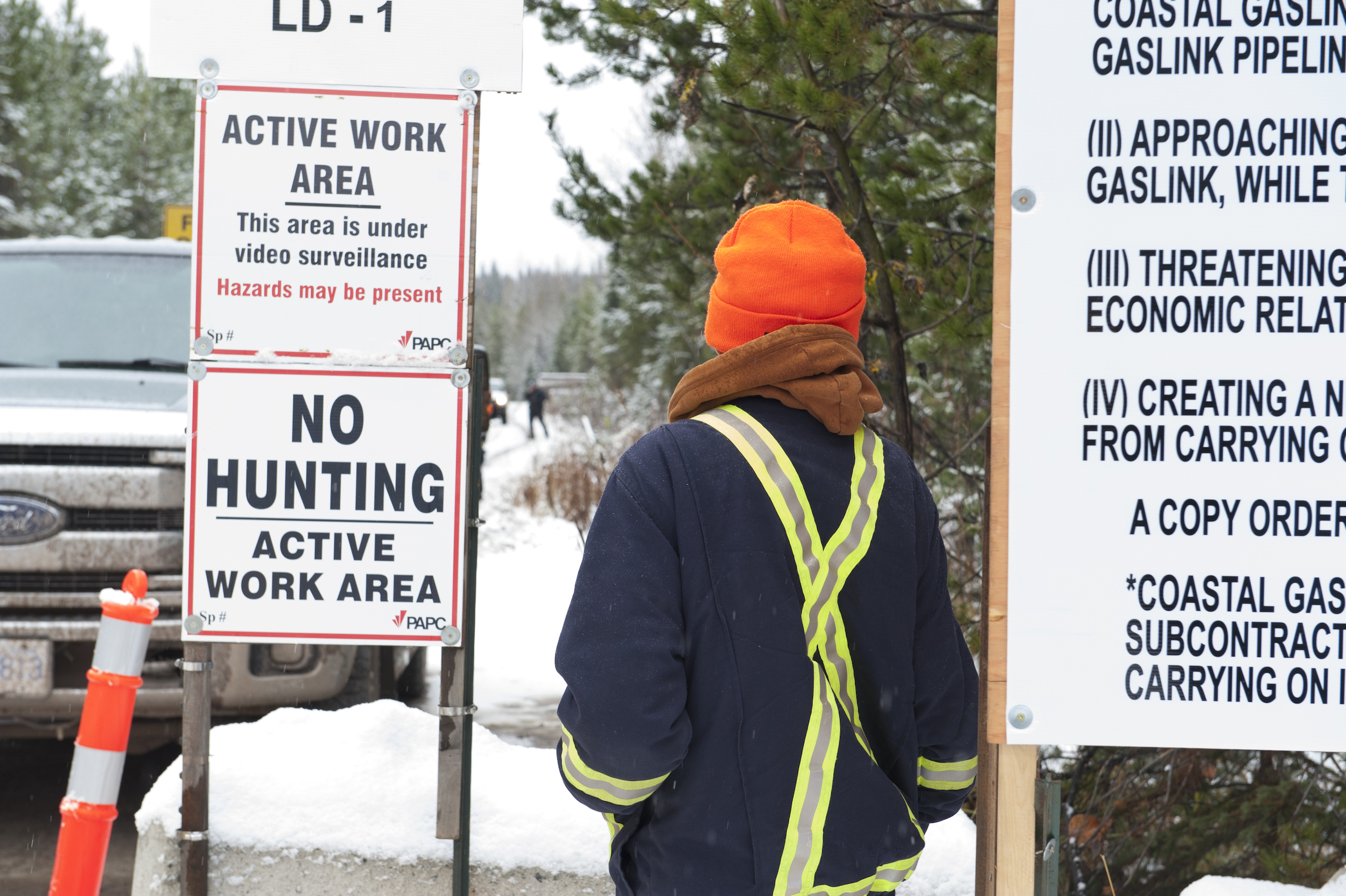
The worker told Na’moks to telephone Ken Floyd, a senior C-IRG officer. No number was provided and cell reception is about an hour’s drive away on the snowy backroads.
Statnyk called after Charney, asking to speak with him and requesting dialogue with a member of the division liaison team, who are often referred to as Indigenous liaisons. The RCMP’s description of C-IRG notes it “uses a measured approach in facilitating the peaceful resolution of public disorder issues” and members of the unit “proactively engage all stakeholders through open communication and meaningful dialogue.” The division liaison team was formed to “build relationships with various interest groups and communities so that we may assist in facilitating a safe environment for everyone exercising their charter rights.”
Charney stopped, turned around and looked back, then continued walking away.
In an emailed statement to The Narwhal, Saunderson, with the RCMP, said members of the division liaison team are “generally not on site.”
“If there’s anything illegal here, it’s happening to me,” Na’moks said. “Threats don’t scare me. They wish to arrest me? Show me the law that they have the right even to detain me.”
The confrontation reflects rising tensions as the Coastal GasLink project construction continues on Wet’suwet’en territory. According to the project website, 100 per cent of clearing on the territory is completed, with 14.3 per cent of the pipe already in the ground.
Alberta-based TC Energy, the pipeline operator, regularly notes the project has the support of 20 First Nations along the route. But Coastal GasLink did not receive Free, Prior and Informed Consent from the Wet’suwet’en Hereditary Chiefs, who famously won a Supreme Court of Canada case that confirmed the Wet’suwet’en had never given up Rights and Title to the 22,000 square kilometre territory.
In April, the United Nations Committee on the Elimination of Racial Discrimination issued Canada a third rebuke for its conduct on Wet’suwet’en and Secwepemc territories. It named C-IRG specifically and reiterated its call to withdraw police and private security services.
Prior to being denied access to the drill site, Na’moks visited another section of the pipeline project, where it crosses Ts’elkay Kwe (Lamprey Creek) just a few hundred metres from a Gidimt’en camp and village site.
There, another security worker read him a different prepared script and did not stop him from observing the work, noting the court injunction relates to any action that impedes construction.
“You’re more than welcome to walk up and down this forest road,” he added.
Na’moks stood looking at the vast worksite and said it used to be a forested ravine, with the creek at the bottom. Now, the landscape is significantly altered by blasting and grading with heavy machinery. Speaking over the sound of bulldozers and industry trucks, he told The Narwhal people need to know what’s happening.
“They’ve killed this creek,” he alleged, watching the machines scrape the land. “I can look at it: it’s dead. We grew up here, we know.”
TC Energy did not respond to the Chief’s comments directly but wrote in an email: “Lamprey Creek remains flowing and controlled blasting was not done in the creek.”
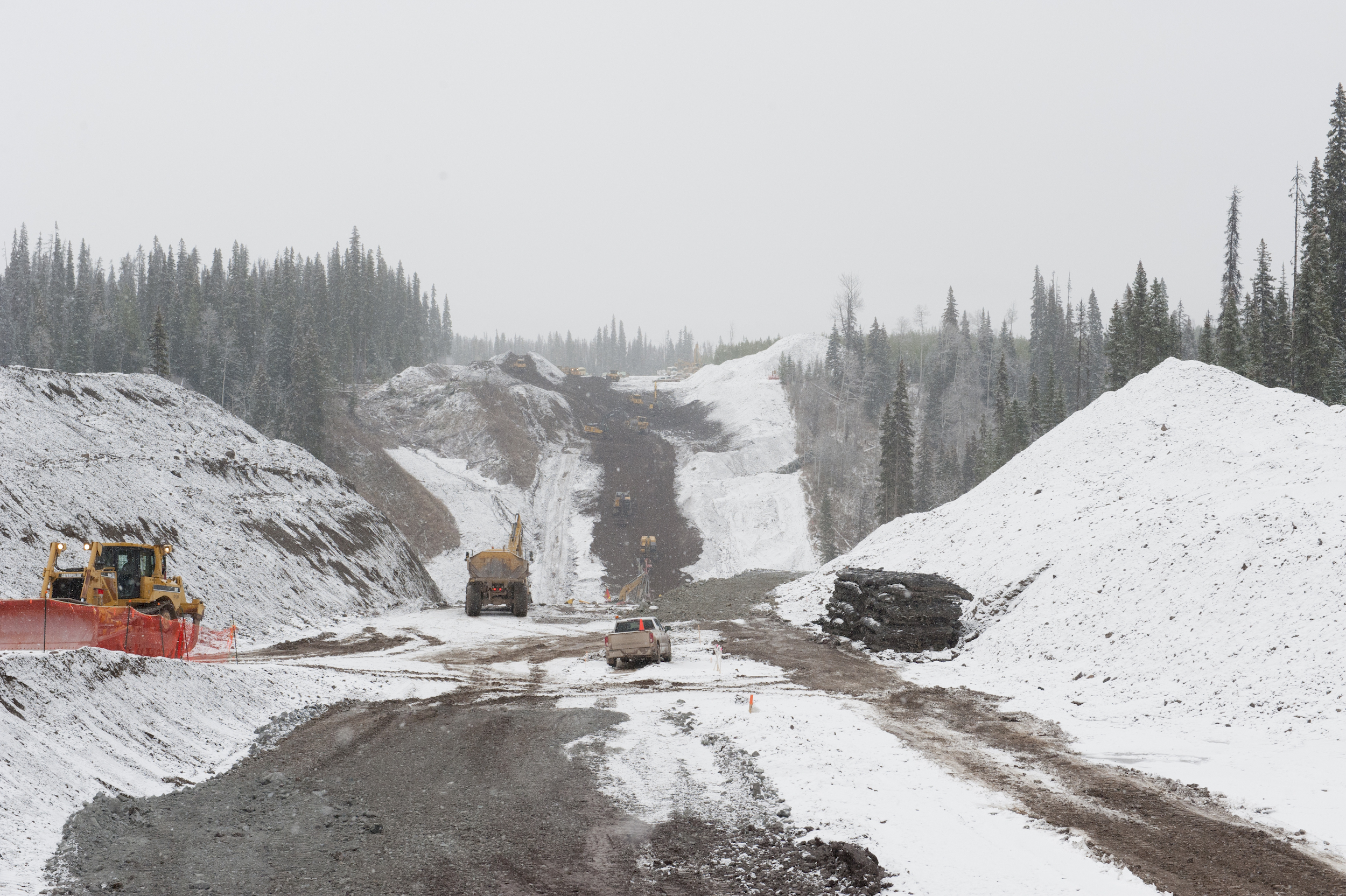
As The Narwhal recently reported, Coastal GasLink didn’t directly inform those at the Gidimt’en camp, less than one kilometre away, before conducting blasting activity, according to Gaylene Morris, a member of Likhsamasyu Clan.
TC Energy told The Narwhal in a previous statement it notified neighbouring communities as part of a general blasting notification and provided local notification around the area in advance of the work. The company also stressed that the activity did not directly impact the creek.
“Controlled blasting activities by Lamprey Creek are part of ongoing clearing and grading activities around the creek … Furthermore, mitigation measures are in place to protect the creek during construction and in accordance with regulatory requirements.”
“What does the future really look like?” Na’moks asked, pain and anger evident in his eyes and grimace. “There has to be a huge shift in the mindset of government if we want this country to remain democratic and strong and free, because right now this is not Free, Prior and Informed Consent. We’ve never agreed to this and we never will. We’re doing our part to protect the planet, protect our land, Rights and Title, our humanity. And this is what we get.”
Back at the gate, Statnyk was growing frustrated.
“You’re being completely uncooperative,” Statnyk told the security workers, after his requests for more information and a means to resolve the standoff without having to drive more than 60 kilometres were unsuccessful.
“You’re going to restrict this Hereditary Chief from peacefully monitoring, which is part of his cultural responsibilities, this ongoing work … He needs to be able to monitor damage to those rights at all times. He’s not looking to interfere with any work whatsoever and the suggestion that walking past this gate is interfering with anyone’s work is laughable.”

Na’moks was quietly livid. His hands shook as he lit a cigarette.
“I’ve just been, as a Hereditary Chief, threatened with arrest on [my] own territory,” he said.
The security worker said it was not a threat: “There’s no threat at all,” he said, laughing. “I’m simply stating. If, if, if you convey that, or, or can see that as being a threat then …”
“That’s exactly how I perceive that,” Na’moks said, cutting him off.
“The human rights abuse here, the Indigenous Rights that are being stomped upon — in one sentence, all of that threat is there,” he continued. “How do I feel? I feel like I’m Wet’suwet’en. I have the right to monitor our land as the Chiefs have been mandated when we become Chiefs. [Canadian] law just happened, they made it up. Our law has been here for thousands of years.”
When able to place a call, Na’moks tried to contact Ken Floyd via the RCMP’s North District media relations officer, Corporal Madonna Saunderson. He left a detailed voicemail but there had been no response prior to publication.
Get the inside scoop on The Narwhal’s environment and climate reporting by signing up for our free newsletter. A $335 million funding commitment to fund...
Continue reading
In Alberta, a massive open-pit coal mine near Jasper National Park is hoping to expand...

A trade war could help remake B.C.’s food system, but will family farmers be left...

First Nations are leading efforts to make sure lake sturgeon can find a home in...
